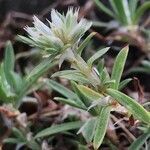Plants perennial, matted; caudex woody. Stems prostrate to ascending, much-branched, 5-60 cm, often retrorsely pubescent on 1 side. Leaves: stipules lanceolate, 2.5-8 mm, apex acute, entire; blade linear to linear-lanceolate or-oblanceolate, 5-30 × 0.5-2 mm, leathery, apex acute, often mucronate, sparsely appressed-pubescent. Cymes terminal, 15-25+-flowered, very compact, forming conspicuous glomerules 10-20 mm wide. Flowers 5-merous, short-cylindric to ovoid, with enlarged hypanthium and calyx cylindric to tapering distally, 3.5-6.5 mm, pubescent with antrorse, slightly spreading, silky hairs; sepals greenish to brownish, veins 3, obscure, ribs absent, narrowly lanceolate, 2-3.2 mm, leathery to rigid, margins translucent, ca. 0.1 mm wide, scarious, apex terminated by awn, hood narrowly triangular, awn straight to slightly divergent, white, 0.9-2 mm, scabrous, spinose; staminodes narrowly triangular, 0.4-0.6 mm; style 1, cleft in distal 6, 1.4-2 mm. Utricles oblong, 1.5-1.8 mm, smooth, pubescent distally.
More
Taprooted perennial with numerous retrorsely silky-hairy, simple or forked stems 5–30 cm, forming mats or tufts; lvs 1–3 cm, linear or lance-linear, acute, apiculate, glabrous to silky; stipules silvery-hyaline, lanceolate, acute; fls sessile in dense cymes, subtended and mostly concealed by the conspicuous silvery bracts; cal 3.5–6 mm, appressed-hairy; sep connate at base, hooded above, with a hirsute awn 0.5–1.5 mm; fr membranous, pubescent at the top. Rocky slopes, ridges, or ledges, usually high in the mts; Me., N.H., and Mass. to Va., W.Va., N.C., Tenn., and Ga. July–Sept.

